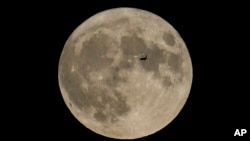ເວລາຈະເຄື່ອນໄຫວໄວຫຼາຍຢູ່ເທິງດວງເດືອນ. ໃນປັດຈຸບັນນີ້ບັນດານັກດາລາສາດສາກົນກຸ່ມນຶ່ງ ໄດ້ເຂົ້າຮ່ວມກັນໃນການຮຽກຮ້ອງເພື່ອຕັ້ງໂມງໃນດວງເດືອນ ສະນັ້ນການປະຕິບັດພາລະກິດອະວະກາດໃນອະນາຄົດ ຈຶ່ງສາມາດຕິດຕາມເວລາຢູ່ເທິງວັດຖຸທີ່ຕັ້ງຢູ່ໃນທ້ອງຟ້ານັ້ນ.
ສະຫະພັນດາລາສາດສາກົນໄດ້ລົງຄະແນນສຽງໃນວັນພະຫັດວານນີ້ ເພື່ອສະໜັບສະໜູນບັນດາອົງການອະວະກາດທົ່ວໂລກໃຫ້ຮ່ວມມືກັນ ກ່ຽວກັບມາດຕະຖານການຈັບເວລາສຳລັບດວງເດືອນ, ເຊິ່ງນຶ່ງວັນແມ່ນມີເວລາເທົ່າກັບ 29 ຊົ່ວໂມງກັບ 5 ນາທີໃນໂລກ.
ທ່ານນາງ ຊູຊານ ສະຈວດ ຈາກອົງການສັງເກດການກອງທັບເຮືອ ສະຫະລັດ ໄດ້ກ່າວໃນອາທິດນີ້ຢູ່ກອງປະຊຸມຂອງກຸ່ມໃນນະຄອນຫຼວງ ເຄບ ທາວ, ປະເທດ ອາຟຣິກາໃຕ້ ວ່າ “ນັ້ນແມ່ນຈຸດສຳຄັນຂອງການແກ້ໄຂບັນຫາຂອງພວກເຮົາ: ຄືການເຮັດວຽກຮ່ວມກັນ ເພື່ອສ້າງຕັ້ງເວລາທີ່ເປັນມາດຕະຖານນີ້.” ທ່ານນາງ ສະຈວດ ໄດ້ເປັນຜູ້ຊ່ວຍເຫຼືອສະເໜີຂໍ້ແກ້ໄຂດັ່ງກ່າວ.
ດວງເດືອນມີແຮງໂນ້ມຖ່ວງໜ້ອຍກວ່າໂລກ, ສະນັ້ນເວລາຈະເຄື່ອນປະມານ 58.7 ລິບດາໄວກວ່າທຸກວັນ. ໃນຂະນະທີ່ມີປະເທດຕ່າງໆ ແລະ ບໍລິສັດເອກະຊົນຫຼາຍຂຶ້ນກວ່າເກົ່າໄດ້ຕັ້ງເປົ້າ ກ່ຽວກັບ ພາລະກິດດວງເດືອນໃນອະນາຄົດນັ້ນ, ບັນດານັກດາລາສາດຈຶ່ງຕ້ອງການໃຫ້ມີໂມງທີ່ເຮັດວຽກປະສານກັນຢ່າງສົມບູນແບບ. ເຊິ່ງໃນປັດຈຸບັນນີ້, ພາລະກິດດວງເດືອນໄດ້ດຳເນີນຂຶ້ນຕາມເວລາຂອງປະເທດທີ່ປະຕິບັດຍານອະວະກາດເທົ່ານັ້ນ.
ອົງການອະວະກາດຢູໂຣບ ໄດ້ທຳການຜັກດັນສຳລັບການສ້າງໂມງດວງເດືອນຂຶ້ນ. ແລະໃນຕົ້ນປີນີ້, ທຳນຽບຂາວໄດ້ຊີ້ນຳໃຫ້ອົງການ NASA ແລະ ອົງການອື່ນໆລວມຕົວກັນສ້າງຄວາມຄິດເບື້ອງຕົ້ນພາຍໃນທ້າຍປີນີ້ ດ້ວຍແຜນການໃຫ້ແລ້ວສຳເລັດພາຍໃນທ້າຍປີ 2026.
ບັນດານັກດາລາສາດແມ່ນຍັງຢູ່ໃນໄລຍະຕົ້ນໆຂອງການພິຈາລະນາວ່າເວລາຢູ່ເທິງດວງເດືອນຈະເຄື່ອນໄຫວແນວໃດແທ້, ທ່ານ ບີຈູນາດ ພັດລາ, ນັກຟີຊິກຢູ່ສະຖາບັນມາດຕະຖານ ແລະ ເທັກໂນໂລຈີແຫ່ງຊາດໄດ້ກ່າວ.
ອ່ານຂ່າວນີ້ເປັນພາສາອັງກິດ
Time moves a tad faster on the moon. Now an international group of astronomers has joined calls to give the moon its own clock so that future space missions can keep track of minutes on the celestial body.
The International Astronomical Union voted Thursday encouraging space organizations across the globe to collaborate on a timekeeping standard for the moon, where one day lasts 29.5 Earth days.
“That’s the crux of our resolution: to work together to establish this standard time,” U.S. Naval Observatory’s Susan Stewart said this week at the group’s conference in Cape Town, South Africa. Stewart helped propose the resolution.
The moon has less gravity compared to Earth, so time ticks by about 58.7 microseconds quicker every day. As more countries and private companies set their sights on future lunar missions, astronomers want to ensure perfect synchrony with a unified clock. Currently, a moon mission runs on the time of the nation that’s operating the spacecraft.
The European Space Agency pushed last year for the creation of a lunar clock. And earlier this year, the White House directed NASA and other agencies to cobble together an initial idea by the end of the year with a final plan due by the end of 2026.
Astronomers are still in the early days of determining exactly how lunar time will tick, said Bijunath Patla, a physicist at the National Institute of Standards and Technology.
“I think that the community has realized that this needs to be done,” Patla said. “And this is the beginning.”






ຟໍຣັມສະແດງຄວາມຄິດເຫັນ